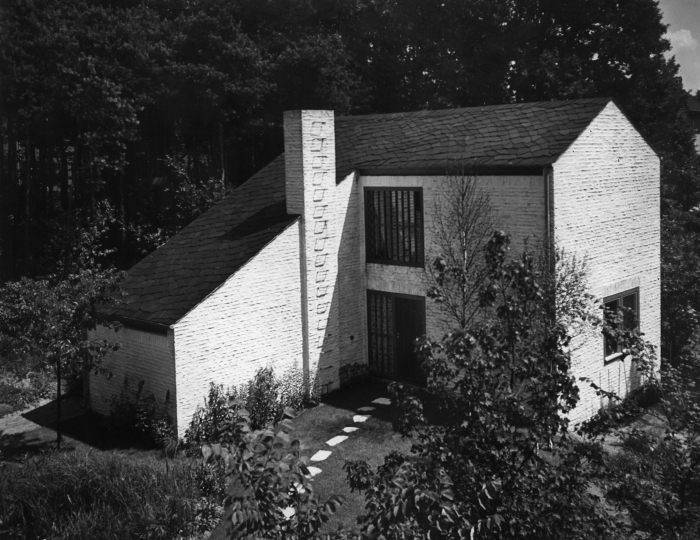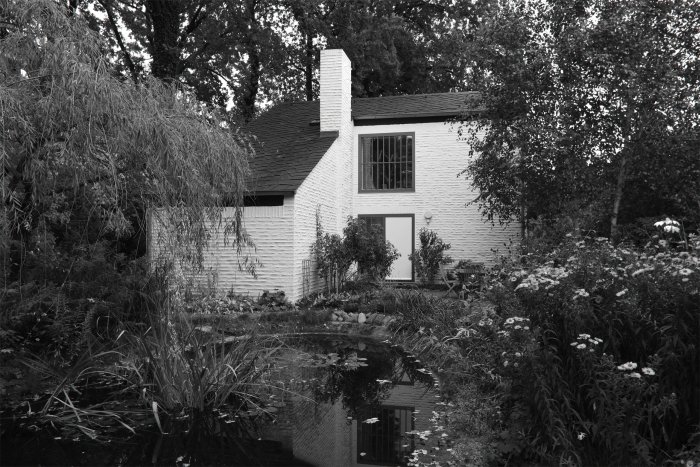On Friday September 26th the Egon Eiermann Society will present the inaugural "Egon Eiermann Chair" Award at a ceremony in the Neue Kaiser-Wilhelm-Gedächtniskirche in Berlin. Initiated to recognise those individuals or organisations who have made an especially valuable contribution to the maintenance and preservation of Egon Eiermann's works the first Egon Eiermann Chair will be awarded to Barbara and Eckard Düwal for their restoration of the so-called Wohnhaus Matthies in Potsdam-Babelsberg. Built in 1937 Wohnhaus Matthies is one of Eiermann's earliest constructions, presents the paired down cottage style that was so typical of much of his early work and has been a listed building since 1977. In 2002 the Architekturbüro Gerald Kühn-von Kaehne und Eberhard Lange were commissioned by Barbara and Eckard Düwal to undertake a restoration and renovation of the property that maintained its character, in essence the work for which the Egon Eiermann Chair is being presented. Ahead of the ceremony we spoke with architect Eberhard Lange about Wohnhaus Matthies, Egon Eiermann's legacy and maintaining that legacy, but began by asking about his own relationship with Egon Eiermann.
Eberhard Lange: With my background in architecture and historic building preservation I am naturally interested in good architecture, and that not just baroque, renaissance or other historical architecture but also modern architecture, for all post-war modernism, and that is of course the period in which Eiermann achieved his fame, if one can phrase it that way. I was obviously familiar with Egon Eiermann, not least because as an architecture student in the DDR one heard about his legendary lectures in Karlsruhe where students would queue up to get in and so I was interested to learn more about his work and got to know a man who is an architect with heart and soul, an architect who doesn't just think stylistically or in context of how a building fits into its location but who considers his buildings to the smallest detail, which I found fascinating. And as architect I have now worked on restoring two Egon Eiermann buildings, the first was the Wohnhaus Henckels in Kleinmachnow and then latterly Wohnhaus Matthies in Babelsberg.
(smow) blog: As you touched upon there, in addition to having worked on Egon Eiermann buildings or works by the likes of Konrad Wachsmann or Erich Mendelsohn you have also worked on numerous older buildings, including works by Schinkel or many of the the Royal Palaces in Potsdam, does one approach lets say "older" historic buildings differently from the more "modern"?
Eberhard Lange: In the first instance one always has respect for the original architect and the work they created, and so in that sense one approaches all projects in the same way. But it is also similar in that the preservation of a construction always begins with an analyse, with research, what type of building is it, how is constructed, what is architecturally interesting and relevant, etc, etc. But at the same time one must focus on the nature of the commission, is it simply maintenance, restoring and repairing, so keeping the work as it is, or are there tasks which go further, a typical example would be insulation or it might be questions about room divisions and the like. And so the work varies more in context of the commission rather than the architect or era.

(smow) blog: The winners of the first Egon Eiermann Chair are Barbara and Eckard Düwal for their efforts in maintaining and preserving the so-called Wohnhaus Matthies. In 1938 Hans Josef Zechlin wrote in the magazine Bauwelt, "The house stands there with a mature self-confidence, as if it has grown there, as if no one had designed it - which is the greatest praise for a building". What makes the Wohnhaus Matthies so interesting for you?
Eberhard Lange: The first thing to say is that Wohnhaus Matthies was realised with limited financial means. It was built for Heinz Matthies, a childhood friend of Egon Eiermann who had recently married and wanted to erect a marital home on part of his parent's land. However, as a young artist Matthies didn't have much money and as such the house is a very simple construction, a very clear simple construction, but the details are fantastic, make the house so interesting and three in particular stand out. The first is the way the windows are integrated into into the walls. To save on work and cost Eiermann negated the usual construction principles and instead used a simple steel L-bracket which supports the window frame and holds it in place, a simple solution and a wonderfully elegant detail. From a structural perspective however very problematic because condensation will inevitably gather behind the bracket, with all the problems that entails; however in the 1930s such things weren't so well understood, and so seen in context it is just the most wonderful solution. Similarly fantastic, if equally problematic, is the so called Quetschfuge on the outer façade. In effect Eiermann made use of the excess mortar that bulges out when one brick is placed on top of another to create a feature. From a design principle a fantastic idea because it gives the structure the most delightful graphic detail, but structurally it's a real problem because the rain runs down them and over the years they crumble and break. But a wonderful piece of design.
(smow) blog: So that means Egon Eiermann had to tell the bricklayers to let the mortar squeeze out from between the bricks, then form it and let it dry? They must have thought he'd lost his marbles....
Eberhard Lange: Yes, almost certainly. As with the third detail, the so-called „wild“ slate cladding, a roofing process that at the time wasn't really known in Northern Germany, it is something much more common in Southern Germany, Bavaria, Tirol, etc.... The local tradesmen here simply couldn't deal with the concept and several gave up before Eiermann eventually found a man in Berlin who was up to the task and could thus create the wonderful roof which gives the house its unique aesthetic.
(smow) blog: Which, to be honest, makes a faithful, yet contemporary, restoration and preservation of such a work sound like a complex and costly business.......?
Eberhard Lange: Absolutely, and the fact that the Düwal's decided to do such is something I personally admire and which is also one of the reasons for awarding them the inaugural Egon Eiermann Chair. Replacing and renewing the damaged Quetschfuge costs time and money, and one could save oneself the work, especially when one knows that it will have to be redone at some point in the future, or when one knows that the window construction is not ideal and could be changed, but decides to leaves it as it is. When, despite knowing what one does about a building, one says I respect such features, I appreciate such features, they are part of the character of my house and I want to keep them, then I think that deserves respect. And one must also remember Wohnhaus Matthies is a fairly small house, especially by modern standards, it is perfect for a couple, but small, and the Düwal's respect it as it is and enjoy it for what it is and have no interest in making changes.
(smow) blog: Other people it seems cannot enjoy Eiermann buildings to the same degree. Amongst other problems Eiermann's IBM Campus in Stuttgart is currently under threat, the future of the Neckermann distribution centre in Frankfurt is still unresolved, should, must, all Eiermann buildings be preserved? Is that important or.....?
Eberhard Lange: Egon Eiermann was active over many years and continually developed as an architect. Just taking the example of his private houses, when one considers the pre-war Wohnhaus Matthies and his own house in Baden Baden from 1962 they are completely different structures, completely different genres, one can't even begin to compare them. Maintaining evidence of this development from the simpler buildings before the war over the larger post war buildings and the much more modern constructions is certainly important. In the opinion of the Egon Eiermann Society it is important to maintain all Egon Eiermann buildings, and that as far as possible in their original condition. When buildings are threatened, such as is the case in Stuttgart or Frankfurt our position is to find good arguments to keep them and use them. Building preservation is however no dogma, and, for example, the Venice Charter, the ground-stone of conservation, says that a building is most usefully retained when it is retained for the good of the community, and that is best achieved when buildings meet contemporary requirements. And so yes, one must occasionally consider what compromises one needs to or should make in terms of for example, insulation, or room size, in order to facilitate the sensible development of the building. Every change hurts, but one undertakes them when one is convinced that through them the building itself wont be lost and that it will become useful for the new generation.
(smow) blog: One must also add that Eiermann himself wasn't shy when it came to demolishing buildings that didn't fit his plans, the best example probably being Erich Mendelsohn's Schocken Department store in Stuttgart. Should one not apply similar standards to his work.......?
Eberhard Lange: Not just Egon Eiermann many other successful, well known architects have demolished and continue to demolish older buildings in order to realise their own projects, it is a situation that will always occur, and from which Egon Eiermann is also affected, his Taschentuchweberei complex in Blumberg for example was recently demolished despite being listed and being one of Eiermann's more interesting industrial buildings. In contrast, with the Kaiser-Wilhelm-Gedächtniskirche in Berlin Eiermann wanted to demolish the ruin of the original steeple, was forced by public pressure to keep it, to integrate it it into his concept. Something he did and eventually accepted. On one side one has the conservator who naturally want to save everything and on the other the social and economic interests who have their wishes, and ultimately one must find the best solution for that building at that time.
(smow) blog: And briefly to end, what do think young architects can learn from Egon Eiermann?
Eberhard Lange: On the one hand Eiermann's personality, he was someone who could convince others and it is important that as an architect you can develop an idea and then convince others that it is correct. That was something Eiermann did very well. In addition as architect one learns from Eiermann to have the courage to try new things, go new ways, for example with materials, one learns to have the courage to develop new ideas and not always reflect backward.
